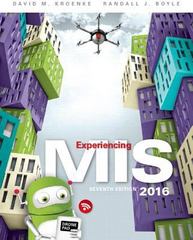Question
I need a response to this discussion post from Nicole Havlichek I would confidently say that Jan and Joop's relationship does not fall under the
I need a response to this discussion post from Nicole Havlichek
I would confidently say that Jan and Joop's relationship does not fall under the classic saying "like father, like son". Throughout this COO transition I would confidently say there will be two different management styles observed by the employees. Change is good, but change is hard. I look forward to discussing my take on how the organization's architecture might optimally change now that Joop has taken over.
We can see that Jan wore a lot of hats within the organization. It is clear that his knowledge and decision rights were linked. This implies that his company was centrally managed, where Jan held multiple decision rights for the company. He was in charge of personnel, menu selection, food suppliers, advertising and more. A downside to this style of management could be that it limits employee engagement. By retaining decision making responsibilities, autonomy is taken away from other leaders.
This ties into the second building block of how to motivate and control behavior, referred to as the "role of knowledge and decision making". This building block implies that any one person does not simply have enough time to adequately acquire knowledge necessary to make all decisions (Zimmerman, 2020). I love the example that the textbook utilized, highlighting Jeff Bezos. We all know the scale of Amazon and know how impossible it would be for one person to manage each element of that business. Unfortunately, with Jan's passing there will not be an opportunity to transfer the knowledge to Joop. Therefore, it would be completely unrealistic to assume that Joop would be grandfathered into all of Jan's prior roles and responsibilities.
Lastly, should Joop stick to the true job responsibilities of a COO versus additionally managing personnel, there could be better managed influence costs. By delegating personnel management to someone else or utilizing bureaucratic rules there may be less bias and more equal treatment. This is where Joop's fresh set of eyes come in to play. Jan has known these employees for many years and had an established belief about his employees. He was paying them fixed salaries that only he was monitoring. This will absolutely create bias and could lead to unfair treatment of employees.
For a lack of better terms, it appears Jan was "gate keeping". With Joop as COO the organization's architecture will hopefully be more transparent, diverse and could ultimately lead to more engaged employees. Joop does seem to fully embody the "work hard, play hard" mentality which could be exactly what this company needs right now.
References:
Zimmerman, J. L. (2020).Accounting for decision making and control. Mcgraw-Hill Education.
I need a response to this discussion post from from Sheridyn Woofter
With Joop taking over as the operating officer of the restaurant chain, several changes in the architecture of the company may occur to adapt to his leadership style. Some potential adjustments may include:
- Delegation and Empowerment: Joop may implement a more decentralized decision-making approach. Instead of Joop making decisions by himself, he could delegate authority to managers or teams within the organization, empowering them to make decisions related to menu selection, advertising, or food suppliers. All of these changes may lead to greater efficiency, innovation and employee engagement.
- Talent Development and Training: Joop may look to invest in comprehensive training programs, leadership development or talent management to retrain skilled employees. All of which could involve promoting from within, providing career advancement opportunities and creating a more positive work environment that shows continuous growth and learning.
- Expansion and Diversification: with Joop's fresh perspective, the restaurant may explore new growth opportunities such as expanding into new markets, introducing innovative menu items or diversifying into related industries such as catering or food delivery. Joop's market analysis skills may also help to identify and capitalize on emerging trends and customer preferences.
- Technology Integration: with a younger mind taking over, Joop may look to prioritize the adoption of new technology to streamline operations, improve customer service and drive the overall business performance. Implementing new technology could involve implementing digital ordering systems or enhancing the online presence of the restaurant chain through social media or other digital marketing channels.
- Governance and Transparency: Joop may look to emphasize corporate governance principles, ethical business practices and complete transparency. He could establish clear new policies or procedures, strengthen communication channels with stakeholders or look to uphold integrity/accountability across all levels of the organization.
Overall, I would foresee Joop's transition into the chief operating officer role as being a positive change. The new role presents an opportunity for Joop to lead the restaurant chain to evolve and thrive in the competitive market by looking to embrace innovation, empowering employees and focusing on sustainable growth.
Step by Step Solution
There are 3 Steps involved in it
Step: 1

Get Instant Access to Expert-Tailored Solutions
See step-by-step solutions with expert insights and AI powered tools for academic success
Step: 2

Step: 3

Ace Your Homework with AI
Get the answers you need in no time with our AI-driven, step-by-step assistance
Get Started


